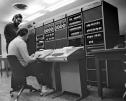Hi all,
the computer graphic pictures/animations from the middle of 80ties are very different compared to the 90ties and later. What were the main differencies in the rendering (raytracing) techniques that were used in 80ties compared to the 90ties?
The objects often looked "phong-solid" rendered (shades of one color) and only on some objects low resolution textures (maybe procedural) were used.
Was also the color pallete smaller? Also the pictures often had much more "cartoon" look and less "contrast". Were mainly 4096 colors (12bit) used in the middle of 80ties? When did the graphic workstations switch to 16,7 mil colors 24bit (RGB) (which were the first workstations using 24 bit colors - maybe the Personal Iris)?
Thanks a lot.
the computer graphic pictures/animations from the middle of 80ties are very different compared to the 90ties and later. What were the main differencies in the rendering (raytracing) techniques that were used in 80ties compared to the 90ties?
The objects often looked "phong-solid" rendered (shades of one color) and only on some objects low resolution textures (maybe procedural) were used.
Was also the color pallete smaller? Also the pictures often had much more "cartoon" look and less "contrast". Were mainly 4096 colors (12bit) used in the middle of 80ties? When did the graphic workstations switch to 16,7 mil colors 24bit (RGB) (which were the first workstations using 24 bit colors - maybe the Personal Iris)?
Thanks a lot.














 (Maradona)
(Maradona)



 , but in early 80it was defined something like a minicomputer for single person (with at least 1(or more?) MIPS performance,1K (1024) pixels resolution, and so one) able to work on engineering tasks indepently (not like terminal).
, but in early 80it was defined something like a minicomputer for single person (with at least 1(or more?) MIPS performance,1K (1024) pixels resolution, and so one) able to work on engineering tasks indepently (not like terminal).






![[[C|-|E]] avatar](../../../static/0523d5bb-607f-410e-9902-4f0ff44d3717.jpeg)